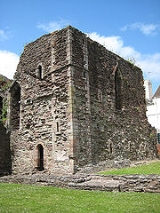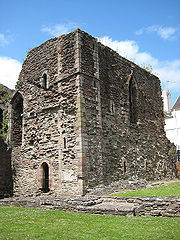
Monmouth Castle
Encyclopedia

Castle
A castle is a type of fortified structure built in Europe and the Middle East during the Middle Ages by European nobility. Scholars debate the scope of the word castle, but usually consider it to be the private fortified residence of a lord or noble...
site in the town of Monmouth
Monmouth
Monmouth is a town in southeast Wales and traditional county town of the historic county of Monmouthshire. It is situated close to the border with England, where the River Monnow meets the River Wye with bridges over both....
, county town
County town
A county town is a county's administrative centre in the United Kingdom or Ireland. County towns are usually the location of administrative or judicial functions, or established over time as the de facto main town of a county. The concept of a county town eventually became detached from its...
of Monmouthshire
Monmouthshire (historic)
Monmouthshire , also known as the County of Monmouth , is one of thirteen ancient counties of Wales and a former administrative county....
, south east Wales
Wales
Wales is a country that is part of the United Kingdom and the island of Great Britain, bordered by England to its east and the Atlantic Ocean and Irish Sea to its west. It has a population of three million, and a total area of 20,779 km²...
.
Location
Monmouth Castle is located close to the centre of Monmouth town on a hill towering over the River MonnowRiver Monnow
The River Monnow flows through south-west Herefordshire, England and eastern Monmouthshire, Wales.- Border River :For much of its short length it marks the border between England and Wales before it joins the River Wye at Monmouth. The Wye is also half English from Monmouth until it meets the...
, behind shops and the main square and streets. Once an important border castle, it stood until the English Civil War
English Civil War
The English Civil War was a series of armed conflicts and political machinations between Parliamentarians and Royalists...
when it was damaged and changed hands three times before suffering the indignity of slighting
Slighting
A slighting is the deliberate destruction, partial or complete, of a fortification without opposition. During the English Civil War this was to render it unusable as a fort.-Middle Ages:...
to prevent it being fortified again. After partial collapse in 1647, the site was reused and built over by Castle House.
Early Norman border castle
It was built by William FitzOsbern, 1st Earl of HerefordWilliam Fitzosbern, 1st Earl of Hereford
William FitzOsbern , Lord of Breteuil, in Normandy, was a relative and close counsellor of William the Conqueror and one of the great magnates of early Norman England...
, the castle
Castle
A castle is a type of fortified structure built in Europe and the Middle East during the Middle Ages by European nobility. Scholars debate the scope of the word castle, but usually consider it to be the private fortified residence of a lord or noble...
builder, in around 1067 to 1071 and shares some similarities with Chepstow Castle
Chepstow Castle
Chepstow Castle , located in Chepstow, Monmouthshire in Wales, on top of cliffs overlooking the River Wye, is the oldest surviving post-Roman stone fortification in Britain...
, another of FitzOsbern's designs further south on the River Wye
River Wye
The River Wye is the fifth-longest river in the UK and for parts of its length forms part of the border between England and Wales. It is important for nature conservation and recreation.-Description:...
in Monmouthshire.
Initially, Monmouth was simply a fairly typical border castle in the Welsh Marches
Welsh Marches
The Welsh Marches is a term which, in modern usage, denotes an imprecisely defined area along and around the border between England and Wales in the United Kingdom. The precise meaning of the term has varied at different periods...
presided over by a Marcher Lord and similar in style and status to its neighbours Grosmont Castle
Grosmont Castle
Grosmont Castle is a ruined castle in Grosmont, Monmouthshire very near the present English / Welsh border, approximately 8 miles northeast of Abergavenny, between Abergavenny, Hereford and Monmouth.-Grosmont Castle:...
, Skenfrith Castle
Skenfrith Castle
Skenfrith Castle is a medieval castle located in Monmouthshire, Wales. The castle is in the centre of the village of Skenfrith, located on the banks of the River Monnow, just five miles to the north of the town of Monmouth...
, White Castle (Wales)
White Castle (Wales)
White Castle is a medieval castle located in Monmouthshire, Wales. The name "White Castle" was first recorded in the thirteenth century, and was derived from the whitewash put on the stone walls. The castle was originally called Llantilio Castle , after Llantilio Crossenny, the mediæval manor of...
or Abergavenny Castle
Abergavenny Castle
Abergavenny Castle is a castle in the market town of Abergavenny, Monmouthshire in south east Wales.- A naturally fortified site :The castle was sited above the River Usk overlooking the river valley and the confluence of the rivers Gavenny and Usk. The site would have been naturally defensible in...
.
Expansion
In 1267, Monmouth Castle passed into the hands of Edmund Crouchback (1245 - 1296), Earl of LancasterEarl of Lancaster
The title of Earl of Lancaster was created in the Peerage of England in 1267, merging in the crown in 1399. See also Duke of Lancaster.-Earls of Lancaster :...
and son of King Henry III of England who redeveloped the castle and expanded it as his main residence in the area. It was also improved by Henry of Grosmont, 1st Duke of Lancaster
Henry of Grosmont, 1st Duke of Lancaster
Henry of Grosmont, 1st Duke of Lancaster, 4th Earl of Leicester and Lancaster, KG , also Earl of Derby, was a member of the English nobility in the 14th century, and a prominent English diplomat, politician, and soldier...
(1310 - 1361).
The castle was a favourite residence of Henry Bolingbroke, later King as Henry IV
Henry IV of England
Henry IV was King of England and Lord of Ireland . He was the ninth King of England of the House of Plantagenet and also asserted his grandfather's claim to the title King of France. He was born at Bolingbroke Castle in Lincolnshire, hence his other name, Henry Bolingbroke...
. It was here that in 1387 the future King Henry V of England
Henry V of England
Henry V was King of England from 1413 until his death at the age of 35 in 1422. He was the second monarch belonging to the House of Lancaster....
was born, to Bolingbroke's first wife Mary de Bohun
Mary de Bohun
Mary de Bohun was the first wife of King Henry IV of England and the mother of King Henry V. Mary was never queen, as she died before her husband came to the throne.-Early life:...
.
Owain Glyndwr
The turmoil and conflict in Wales during the ten years of the Owain GlyndwrOwain Glyndwr
Owain Glyndŵr , or Owain Glyn Dŵr, anglicised by William Shakespeare as Owen Glendower , was a Welsh ruler and the last native Welshman to hold the title Prince of Wales...
rebellion did not directly affect Monmouth Castle as it was a stronghold of the region and lesser targets presented themselves more readily to essentially a guerilla army. However other local towns, settlements and castles were directly attacked with Grosmont
Grosmont
Grosmont is a small village and civil parish situated in the Scarborough district of North Yorkshire, England and is within the North York Moors National Park. The village is named after the Grandmontines Priory that used to be there...
and Abergavenny
Abergavenny
Abergavenny , meaning Mouth of the River Gavenny, is a market town in Monmouthshire, Wales. It is located 15 miles west of Monmouth on the A40 and A465 roads, 6 miles from the English border. Originally the site of a Roman fort, Gobannium, it became a medieval walled town within the Welsh Marches...
being razed and Crickhowell
Crickhowell
Crickhowell is a small town in Powys, Mid Wales.-Location:The name Crickhowell is taken from that of the nearby Iron Age hill fort of Crug Hywel above the town, the Welsh language name being anglicised by map-makers and local English-speaking people...
Castle and Newport Castle
Newport Castle
Newport Castle is a castle ruin in the city of Newport, South Wales and is a Grade II* Listed building. It is the castle that gives Newport its original and real name in the Welsh language, Castell Newydd, shortened to Casnewydd...
successfully attacked.
Civil War
In the tumult of the English Civil WarEnglish Civil War
The English Civil War was a series of armed conflicts and political machinations between Parliamentarians and Royalists...
, Monmouth Castle changed hands three times and was slighted to prevent its military re-use. This sanctioned the demise of the castle which collapsed a few years later. The site was readily redeveloped.
Today
Only fragments of the castle remain above ground, and on the site Castle House and Great House have been built http://www.geograph.org.uk/photo/64748, in 1875 the Royal Monmouthshire Royal EngineersRoyal Monmouthshire Royal Engineers
The Royal Monmouthshire Royal Engineers is the most senior regiment in the British Territorial Army, having given continuous loyal service to the crown since 1539. It is part of the reserve forces, and is the only remaining Militia unit in the British Army...
Militia
Militia
The term militia is commonly used today to refer to a military force composed of ordinary citizens to provide defense, emergency law enforcement, or paramilitary service, in times of emergency without being paid a regular salary or committed to a fixed term of service. It is a polyseme with...
, the senior TA
TA
TA may be an abbreviation for:* EMC TA, an American diesel-powered locomotive* T.A. , 2002 album by the post-rock band Trans Am* T.A...
regiment today, made their HQ building here and it remains so today. It is one of the few British castles in continuous military occupancy.

